Anatomy of the Spine
The human spine is made up of 5 main segments, the cervical, the thoracic, the lumbar, the sacral, and the coccyx. Each segment consists of individual bones known as vertebrae which are stacked upon each other.
The cervical spine consists of 7 vertebrae, the thoracic 12 vertebrae, and the lumbar consists of 5 vertebrae. The 5 vertebrae of the sacral region are fused together to form one bone. Similarly, the 4 vertebrae of the tailbone (coccyx) are also fused together to form one bone.
The shape and size of the vertebrae in different segments results in a characteristic double ‘’S’’ shape of the vertebral column in an upright position. The cervical spine is naturally bent with an inward curve, the thoracic is bent with an outward curve and the lumbar is bent with an inward curve.
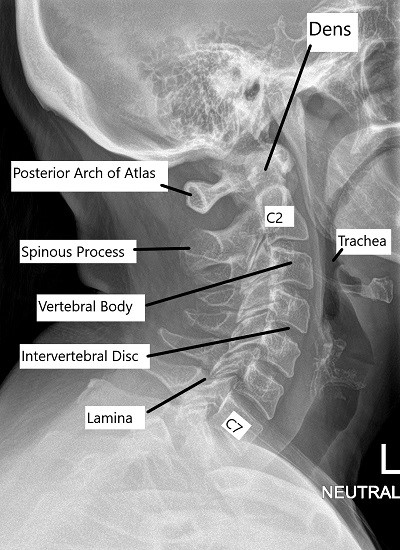
X-ray of the normal Cervical and Lumbar Spine.
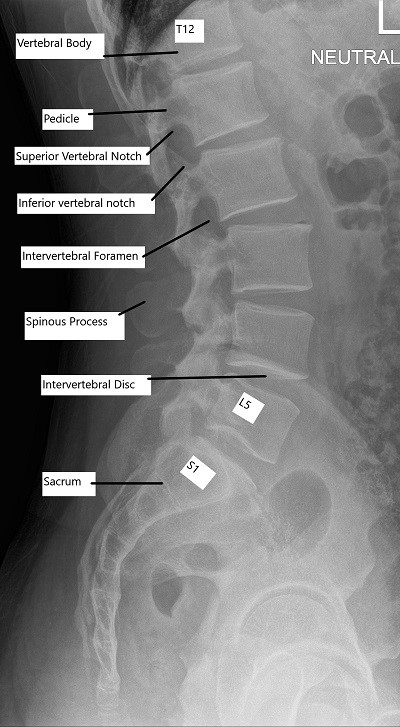
X-ray of the normal Cervical and Lumbar Spine.
The cervical spine starts from the base of the skull and ends in the upper chest. The cervical spine helps in the movement of the head while providing stability. The thoracic spine connects the cervical spine with the lumbar spine, starting in the upper chest and ending in the mid-back.
The thoracic spine connects with the rib cage. The lumbar spine consists of large vertebrae as it supports the body weight, connecting the upper body with the pelvis.
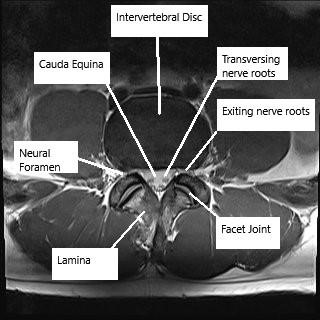
MRI showing the lumbar spine in the axial and sagittal section.
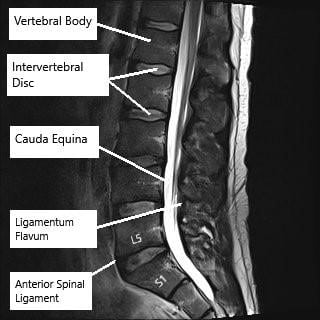
MRI showing the lumbar spine in the axial and sagittal section.
Each vertebra creates a canal upon stacking on each other, creating a safe conduit for the spinal cord and the nerve roots. The spinal cord travels from the base of the brain through an opening in the lower skull and ends at the level of the 1st and 2nd lumbar vertebrae. After the spinal cord ends near L1 and L2 vertebrae it continues down as a bundle of nerves known as cauda equina.
The spinal cord gives branches which pass through the openings in the vertebrae known as the intervertebral foramen. These exiting nerves serve as a connection between the brain and the spinal cord with the tissues they supply.
The facet joints are responsible for the natural curves in the vertebral column. They also provide stability to the vertebral column and aids in its movement. Each vertebra has 2 pairs of facet joints, one pair facing upwards connecting with the vertebrae above and the other pair facing downwards, connecting with the vertebra below.
The facet joints stabilize the vertebral column during various movements such as twisting, bending forward, or backward. Like other joints in the body. Each facet joint is covered by a capsule. The ends of the bones forming the facet joints are covered with a protective tissue known as cartilage. The capsule of the joint secretes watery thin fluid to lubricate and nourish the joint.
The intervertebral disks connect each vertebral body with each other. The intervertebral disks are flat disc-shaped tissues that act as a cushion between the adjoining vertebrae. Each disk is made up of a thick fibrous outer ring known as the annulus and a soft inner center known as the nucleus pulposus. The nucleus pulposus has a gel-like consistency which gives the disk its flexibility and shock-absorbing property.
Ligaments are strong fibrous tissues connecting vertebrae. Various ligaments connect the corresponding vertebrae. Together, the spinal ligaments provide structural stability to the vertebral column at rest and during movement.
Spinal muscle and tendons around the vertebral column together help to move the column and provide stability. The muscles and tendons attached at the back and the sides help to bend the spine backward and the muscles in the front including the abdominal muscles help to bend the spine forward.
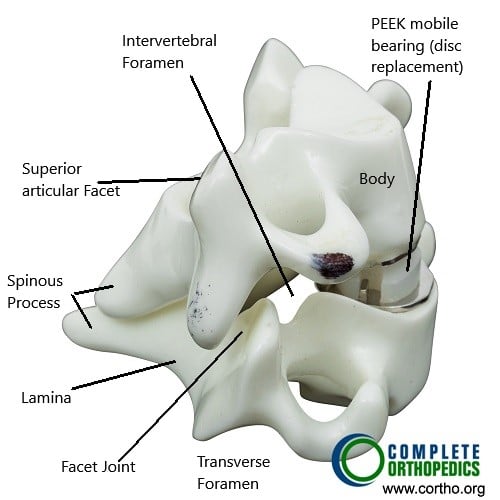
Cervical spine with prosthetic disc
The above image shows a cervical spine vertebra with a prosthetic cervical disc. The prosthetic disc may be used to treat patients with diseased cervical intervertebral disc. The disc replacement has an advantage of maintaining the motion of the diseased segment as opposed to cervical spine fusion.
Do you have more questions?
Do pinched nerves go away on their own?
The pinched nerves are usually caused due to inflammation of the nerve roots near the spinal cord where they exit. The inflammation, once improved, causes relief in the pinched nerve. This improvement in inflammation can be caused rest, anti-inflammatory medication, steroid medications or cortisone shot. Occasionally the cause of inflammation may be persistent compression over the nerve, which may not get better with all form of conservative management.
What is mild back sprain, and how do you fix it?
Back sprain means injury to the ligaments or the muscles of the back. It can usually happen due to certain activity or may be with a fall or accident. The underlying cause of a back sprain may be weakening of the muscles of the back which may predispose the person to develop back sprains. If a back sprain is recurrent, then they may need physician medical attention to take care of their back so as to prevent further recurrences.
An episode of back sprain can usually be treated with short term rest for one to two days along with anti-inflammatory medications and use of ice or heat to decrease the pain. This should be followed by usual activity as well as exercises involving strengthening and stretching of back muscles.
Can I jog if I have a back sprain that is hurting?
If jogging causes worsening of the back sprain, then it should better be avoided. If comfortable, one can try to do walking or fast walking too in place of jogging.
What is the most effective way to treat the low back pain due to lumbar strain?
Low back pain can usually be treated with short period of rest for one to two days along with anti-inflammatory medications followed by stretching and strengthening exercises of the back. These exercises can be done at home or at the gym with or without supervision of a personal trainer. If the patient has recurrent episodes, then they should seek medical attention to learn a specific type of exercise and to rule out other possibilities or reason for recurrence of back pain.
How do I sleep with the low back pain?
The patient with low back pain may have difficulty sleeping in specific positions. They should try avoiding that and may sleep by the side. They should also try to keep pillows between the legs while sleeping by the side or under the knees when sleeping on the back.
Is it best to rest for a sore back?
For a sore back or low back pain, a short term rest for one to two days may be helpful. Rest for longer periods have not been found to cause much effect in the long term and should be avoided. Prolonged rest can cause weakening of the muscles which may predispose to recurrence of back pain.
What you do for a pinched nerve in the lower back?
Most patients who have pinched nerve in the lower back present with sciatica or pain radiating down the leg. This may or may not be associated with tingling or numbness. Such patients are usually treated with medications and exercises. If the pain, tingling, and numbness are not relieved with conservative means, then these patients may need to undergo advanced imaging in the form of MRI to rule out disc disease and be treated accordingly.
What muscles are affected by the C5 and C6 nerves?
C5 and C6 nerves innervate the muscles of the shoulder and the elbow. The patients who has involvement of C5 and C6 will have pain over a shoulder and the upper arm and going up to the outer side of the forearm and the thumb. These patients may have tingling and numbness of the same area and may have weakness in the shoulder and the elbow presenting in the form of elevating the shoulder and bending the elbow.
How do you sleep after back surgery?
There are usually no restrictions with regards to the sleeping habits after back surgery. The patients can sleep in comfortable position either on the back or by the side as they feel more comfortable. They may need to use multiple pillows to make them comfortable in bed.
What happens when you have a spinal fluid leak?
Spinal fluid leak after a spine surgery usually happens due to the injury to the set of the nerve roots of the spinal column. If the spinal fluid leak is detected during the surgery, it is usually sutured and treated accordingly. If the spinal fluid leak is not detected during the surgery or if the repair not water tight then the patient may have headache especially while sitting and standing.
These patients are usually treated with medications and IV fluids. If the patient failed to improve with conservative means, then they may need to undergo surgery for the repair of the leak.
Can you drive after back surgery?
Patients who undergo back surgery are asked not to drive until they are off pain medications as well as they are comfortably sitting in a car, in a chair for prolonged period.
What helps with neck pain?
Patients with neck pain can usually be treated with short period of rest along with antiinflammatory medications. They can also wear a soft collar if that is helpful in pain relief. Patients are encouraged to strengthen their neck muscles over a period of time with or without supervision of a physical therapist so as to treat neck pain as well as prevent recurrences.
Can a neck pain be something serious?
About neck pain which is not improved with over-the-counter medications and or is worsening or causes radicular pain around the arm or the leg, electric shock-like sensations down the body or associated with tingling, numbness, weakness, or involvement of bowel or bladder can be serious and these patients should seek medical attention so as to rule out other possible causes of neck pain. if the patient has fever with or without chills or has a history of malignancy in the past, then the patient should also seek medical attention to rule out infection or malignancy involving the bones.
How do I sleep with neck pain?
Patients with neck pain usually have sore muscles of the neck and they may need special pillows so as to prevent awkward positioning of the neck. They should avoid multiple pillows and should try to sleep by the side or use a contoured pillow so as to keep the neck straight.
Can exercise help neck pain?
Exercise are of tremendous help in patients with neck and back pain. They help in strengthening the muscles and thereby improving the health of the muscles. Strong muscles offload the bones of the neck and help in relieving the neck pain.
What is spondylosis of the neck?
Spondylosis is another term for degeneration or osteoarthritis of the bones of the neck. They usually present with neck pain with or without radiating pain down the arms. X-rays of the neck may show signs of osteoarthritis in the form of leaking or bone spurs.
Can a neck pain be caused by cancer?
Though a rare cause, but there is a possibility for a cause of neck pain. Any patient who has longstanding neck pain which is not relieved with conservative needs or has a history of malignancy in the past or have unintentional weight loss should seek medical attention to rule out the diagnosis.
Can a pinched nerve go away on its own?
Most of the patient’s with pinched nerve usually improves over time and pressure of the nerve is decreased due to the healing mechanism of the body. Only if the patient is not relieved of symptoms of pain, tingling or numbness, or there is worsening of symptoms and pain with or without involvement of muscles in the form of weakness or bowel or bladder, then these patients should seek medical attention.
What are the signs of pinched nerve in the neck?
Pinched nerve in the neck usually presents with radicular pain going down their arms. This may or may not be associated with tingling or numbness. If the pain is associated with weakness of the muscle, then the patient should seek urgent medical attention

Dr. Suhirad Khokhar
My name is Dr. Suhirad Khokhar, and am an orthopaedic surgeon. I completed my MBBS (Bachelor of Medicine & Bachelor of Surgery) at Govt. Medical College, Patiala, India.
I specialize in musculoskeletal disorders and their management, and have personally approved of and written this content.
My profile page has all of my educational information, work experience, and all the pages on this site that I've contributed to.
